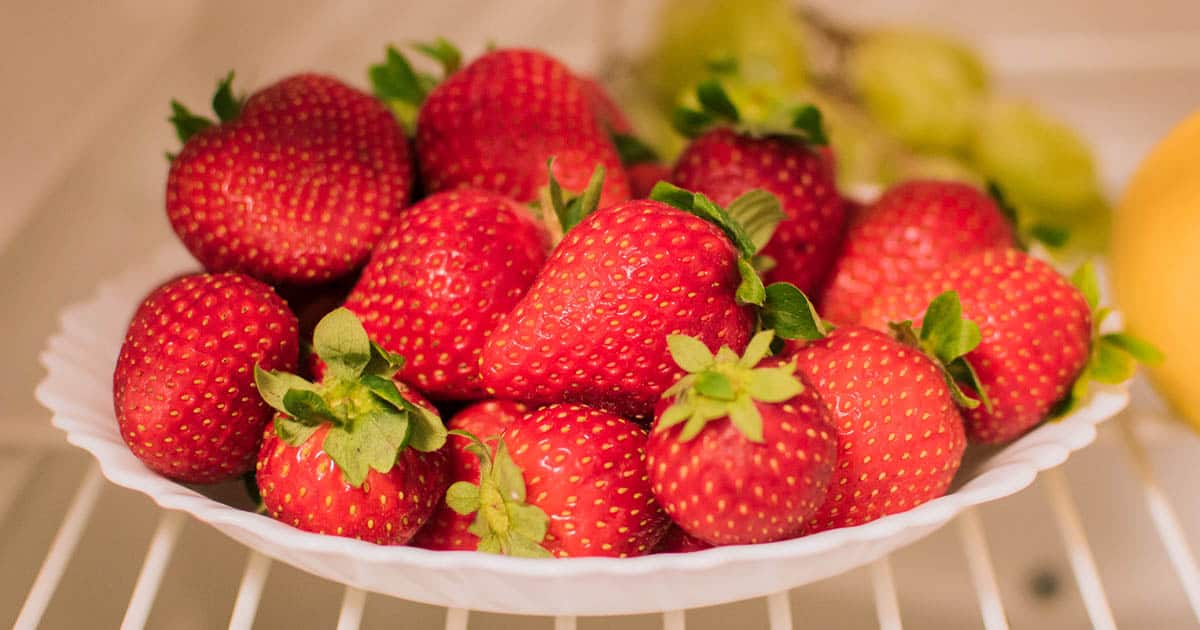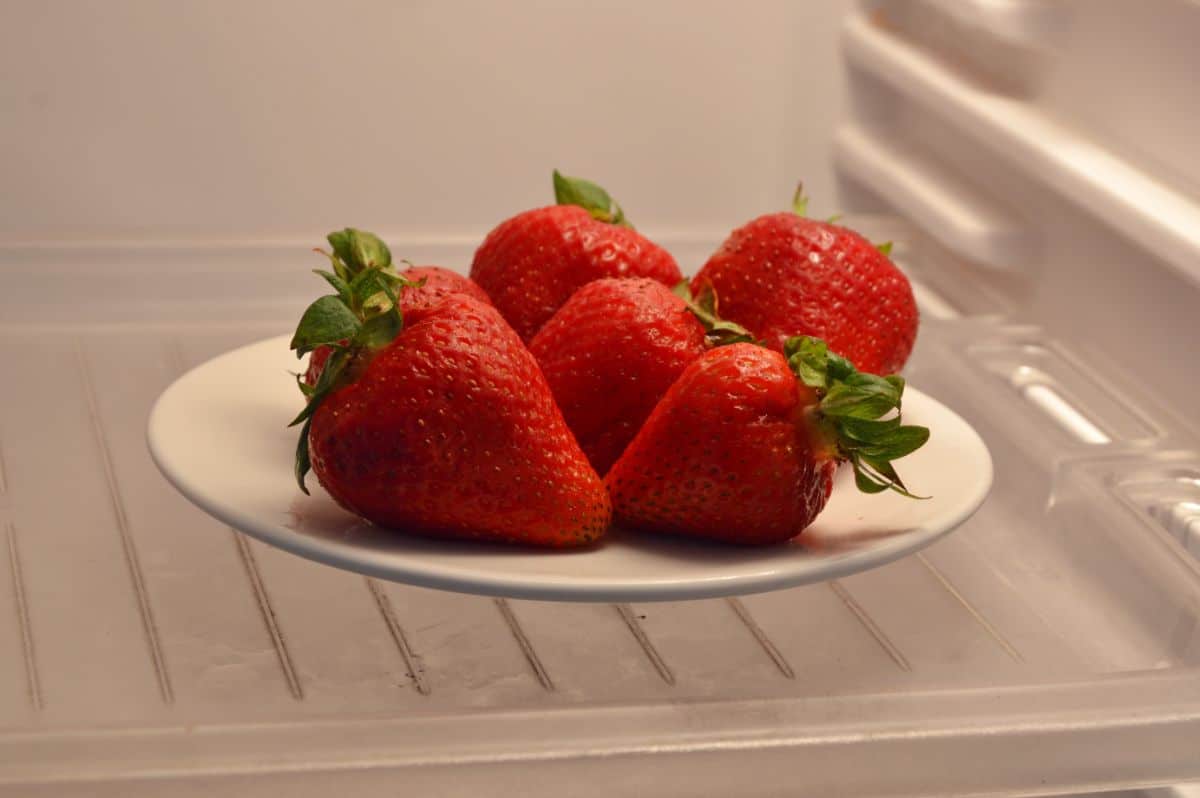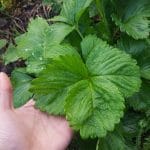Do you ever buy a flat — or maybe two or three flats — of strawberries only to have half of them go bad in just a day or two? Choosing the right strawberries and storing them the right way can make a huge difference in how long your strawberries stay as fresh, juicy, and delicious as the day you bought them. Here are eight suggestions for keeping strawberries first-day fresh.

Jump to:
- Buy the Best Strawberries
- Always Inspect Your Berries Carefully
- Do Not Wash Strawberries Before You Put Them in the Refrigerator
- Never Put Strawberries on the Top Shelf of Your Refrigerator
- But Considering Using Ultrasound to Keep Your Strawberries Fresh
- Leave Stems and Leaves on Your Berries as Long as Possible
- Never Buy Strawberries That Have Been “Nuked” To Keep Them Fresh
- Planning to Use Strawberries More Than Five Days After You Buy Them? Freeze Them!
Buy the Best Strawberries
It’s hard to go wrong with luscious, irresistible strawberries you buy directly from the grower, but when you buy strawberries at the supermarket it is best to rely on the federal food inspector.
The US Department of Agriculture certifies the safety and freshness with a grading system. Agricultural inspectors sample at least 1 percent or at least three clamshell containers from every shipment.
For instance, if a grower is shipping 200 clamshell containers of strawberries to a supermarket, the inspector will randomly choose three clamshell containers for closer inspection (minimum of three). If a grower is shipping 500 clamshell containers of strawberries to market, the inspector will look at five containers (1 percent). Strawberries can get one of three different passing grades on a somewhat complicated grading system.
- To be sold as USDA No. 1 strawberries, at least 95 percent of the strawberries in every sample must have a diameter of at least three-quarters of an inch. At least 95 percent of berries must have red color over 75 percent or more of their surfaces. And no more than 2 percent of berries can show any signs of decay.
- To be sold as USDA No. 2 strawberries, at least 95 percent of berries must have a diameter of at least five-eighths of an inch. They can be just a little smaller than No. 1’s. Berries must have color over at least 50 percent of their surfaces. Up to 10 percent of berries in each sample can be too small or unripe, and no more than 3 percent can show signs of decay.
- Combination strawberries can have up to 20 percent berries that are too small or unripe, and no more than 2 percent berries that are affected by decay. At least 65 percent of the berries in every sample could have been graded No. 1 if they had not been mixed with berries of less quality.
USDA guidelines specify a great deal more than size and color. Inspectors will take the temperature of strawberries with a thermometer. They will look for flattened, sunken, mushy, bruised berries and berries that are overripe. They will note berries that have been pecked by birds, gnawed by rodents, or scarred, and berries that have been soaked in the rain or sunburned. They will make sure all the berries in a shipment are the same variety. Visible dirt or caked-on mud is unacceptable.
What USDA guidelines can’t specify is taste. The most colorful berries are the most nutritious, and they are usually but not always the tastiest, too. Since we all eat with our eyes, it’s always best to buy the highest grade of strawberries you can find in your market.
Look for the USDA shield on the container. It will tell you the grade the inspector gave the strawberries. Remember, unless strawberries are offered at an extremely low price and you intend most of their flavor to come from added sugar, USDA No. 1 berries are preferable. You are not likely to be happy with strawberries given a USDA grade of No. 2.
Don’t expect berries to get better after you get them home. Strawberries do not ripen after they have been picked. Any pale berries will continue to be pale no matter how you store them.
Always Inspect Your Berries Carefully

USDA inspection guidelines permit 2 percent of berries to be moldy. You won’t see a moldy berry in the bottom of a clamshell container unless you take the time to look. Flip the container over to inspect the berries in the bottom before you buy it. If you miss a moldy berry at the store, remove it before you put the clamshell container in the refrigerator.
It is even more important to inspect strawberries you buy in flats. Flats hold more strawberries that can be ruined by spreading mold. Even if you do not inspect the flat at the roadside stand where you buy it, look carefully at all the berries in the flat before you put them in the refrigerator.
Do Not Wash Strawberries Before You Put Them in the Refrigerator
It’s natural to want to wash produce you buy at the store, the farmer’s market, or from a roadside stand. After all, you don’t know what kinds of chemicals and grime could have settled on them. But resist the urge to wash berries when you get them home. Here’s why:
Strawberries are little sponges. If you rinse them with tap water, they will absorb enough water to dilute their flavor. The added water will also super-charge the growth of mold from spores in your refrigerator. If you rinse your strawberries with a mixture of vinegar and water, studies with a similar chemical find, they won’t lose color or flavor, but the vinegar will leach out the anthocyanin pigments that help to make them a healthy and visually appealing fruit.
Rinsing strawberries will not remove pesticides or fungicides, although scientists say that soaking strawberries in freshwater for 30 minutes, pouring off the soaking liquid, and giving the berries a second rinse will remove most of the residue from mite-killer bifenazate and the fungicide tetraconazole.
Both of these products are commonly used on strawberries grown in greenhouses. The soaking process greatly reduces both the flavor and storage life of berries. It is better to buy organic or stick to strawberries grown in season outdoors.
Never Put Strawberries on the Top Shelf of Your Refrigerator
Produce on the top shelf of the refrigerator tends to freeze, but it will dry out first. Keep your strawberries in the produce drawer, but make sure the produce drawer is free of decaying fruits and veggies or any signs of mold. Just say no to washing strawberries, until just before it is time to eat them.
But Considering Using Ultrasound to Keep Your Strawberries Fresh
No, this doesn’t mean you shout and scream at mold to frighten it off your berries. Home ultrasound machines are a reliable way to treat all of your produce, not just your strawberries. You just put your produce in the ultrasound container for 30 to 60 seconds to shake loose bacteria, molds, fungus, and dirt.
Leave Stems and Leaves on Your Berries as Long as Possible

Have you ever noticed that the expensive chocolate-dipped strawberries you see in the store for Valentine’s Day and other special occasions always have their stems? The reason fancy strawberries come with their stems is to prolong freshness. The stem continues to provide hydration to the strawberry even after it is cut off the vine, as long as it is intact. That is why you always see the stems on expensive chocolate-dipped strawberries. Even the crown of leaves around a strawberry will keep the fruit fresher.
Never Buy Strawberries That Have Been “Nuked” To Keep Them Fresh
For over 25 years an office of the United Nations known as the International Consultative Group on Food Irradiation has encouraged producers of berries and fresh vegetables to pass them through irradiation chambers to prevent decay and to preserve freshness on the supermarket shelf. Irradiated strawberries are sold in over 50 countries, including the United States.
It’s true that irradiated strawberries are far less likely to get moldy. Any insects on them are killed by radiation. And your body does not absorb any radiation from their irradiated strawberries.
Irradiated strawberries are surprisingly safe to eat. But there is a better way to treat strawberries to keep them mold- and insect-free.
Strawberries that have been passed through blue light, the same blue light that you see when you look up into the sky, only at greater intensity, also keep longer on the shelf. But the blue light in the treatment has an additional benefit. Blue light also activates enzymes that cause the strawberry to keep on producing healthy anthocyanins.
These are the plant pigments that can strengthen your blood vessels and reduce your risk of a heart attack. Chinese scientists have found that treatment with visible blue light increases activities of an astonishing array of beneficial enzymes including anthocyanin synthase, cinnamate-4-hydroxylase, glucose-6-phosphate, tyrosine ammonia-lyase, shikimate dehydrogenase, phenylalanine ammonia-lyase, 4-coumarate/coenzyme A ligase, chalcone synthase, dihydroflavonol-4-reductase, flavanone-3-β-hydroxylase, and UDP-glycose flavonoid-3-O-glycosyltranferase.
All these chemicals with the hard-to-pronounce names work together to make your strawberries even more richly red and flavorful. It sounds a little odd, but the same blue light devices you can use for treating skin conditions can also improve the flavor of strawberries.
Even better, blue light doesn’t kill some of the useful yeasts that naturally grow on strawberries. There are naturally occurring strains of probiotic yeasts that grow in low-humidity conditions. They actually bring out flavors in strawberries you keep in the refrigerator, as long as you the producer doesn’t zap them with radiation and you don’t kill them with bleach or other food-unfriendly household products when you get them home from the market.
What about spreading out your strawberries across a paper towel on a plate to keep them drier by letting air circulate around them? This common suggestion doesn’t really work. It tends to dry out the strawberries, and they tend to roll off the plate and get lost in the refrigerator.
Planning to Use Strawberries More Than Five Days After You Buy Them? Freeze Them!
When you don’t plan to use strawberries within a week of buying them, your best bet is to freeze them. Remove the leaves, cut them in half, or slice them if you like, and then place them on a cookie sheet in a single layer in the freezer until they are frozen. Then store the frozen strawberries in plastic bags.
Read our comprehensive guide on how to freeze strawberries.
It would be ideal if strawberries could be eaten at the peak of flavor and color fresh off the vine. But with a few precautions, you can preserve and sometimes even enhance their flavor with the right approach to refrigerated storage.










Leave a Reply